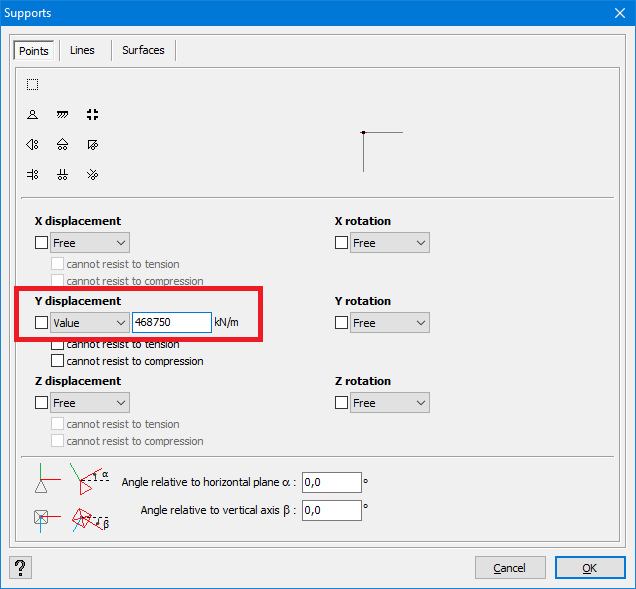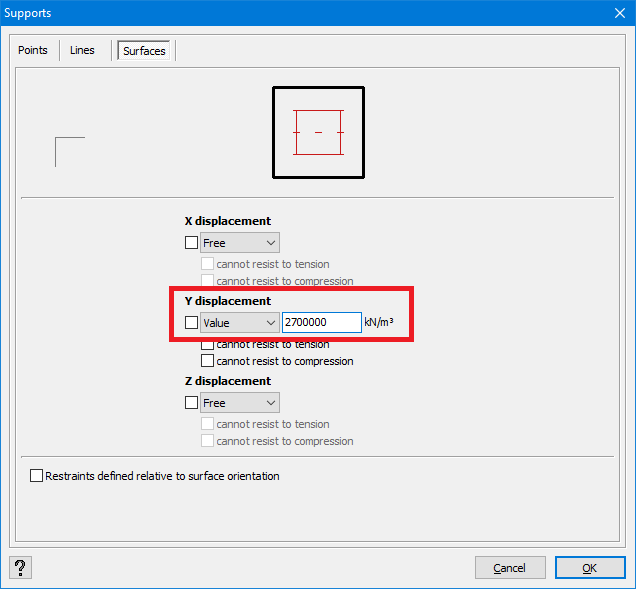The goal of this article is to translate the stiffness of a vertical elements (column, wall, surface support) to a spring constant ![]() which can be applied in the Y-direction in Diamonds.
which can be applied in the Y-direction in Diamonds.
For a point support (column or foundation pile)
With Hooke’s Law ![]() and the formula for stress
and the formula for stress ![]() , a formula for the spring constant can be deducted. This formula assumes that the element is supported at the buttom.
, a formula for the spring constant can be deducted. This formula assumes that the element is supported at the buttom.
![]()
with
 the modulus of elasticity of the column
the modulus of elasticity of the column the cross-section area of the column
the cross-section area of the column the length of the column
the length of the column
For a line support (wall)
Again Hook’s law and the formula for stress are used. But since the length the wall will be modelled as a line support, this dimension is no longer in the formula:
![]()
with
 the modulus of elasticity of the wall
the modulus of elasticity of the wall the thickness of the wall
the thickness of the wall the height of the wall
the height of the wall
For a surface support (foundation pit)
Again, same principle, but both dimensions of the surface support will be modelled. Which gives this as the formula for the spring constant:
![]()
with
 the modulus of elasticity of the surface support
the modulus of elasticity of the surface support the height of the pit
the height of the pit
Het doel van dit artikel is om de translatie stijfheid van een verticaal element (zoals een kolom, wand of funderingsput) te vertalen naar een veerconstante ![]() die dan toegepast kan worden in de Y-richting in Diamonds.
die dan toegepast kan worden in de Y-richting in Diamonds.
Voor een puntvormige ondersteuning (kolom of funderingspaal)
Met de web van Hooke ![]() en de formule voor spanning
en de formule voor spanning ![]() , kan de formule voor de veerconstante
, kan de formule voor de veerconstante ![]() afgeleid worden. Deze formule verondersteld dat het element onderaan gesteund wordt.
afgeleid worden. Deze formule verondersteld dat het element onderaan gesteund wordt.
![]()
met
 de elasticiteitsmodulus van de kolom
de elasticiteitsmodulus van de kolom de oppervlakte van de kolom
de oppervlakte van de kolom de lengte van de kolom
de lengte van de kolom
Voor een lijnvormige ondersteuning (wand)
Opnieuw worden de wet van Hooke and de formule voor spanning gebruikt. Maar aangezien de lengte van de muur gemodelleerd wordt, is deze dimensie niet langer aanwezig in de formule:
![]()
with
 de elasticiteitsmodulus van de muur
de elasticiteitsmodulus van de muur de dikte van de muur
de dikte van de muur de hoogte van de muur
de hoogte van de muur
Voor een oppervlakte ondersteuning (funderingsput)
Opnieuw worden de wet van Hooke and de formule voor spanning gebruikt. Maar aangezien de lengte en breedte van de funderingsput gemodelleerd worden, zijn deze dimensies niet langer aanwezig in de formule:
![]()
with
 de elasticiteitsmodulus van de funderingsput
de elasticiteitsmodulus van de funderingsput de diepte van de funderingsput
de diepte van de funderingsput





